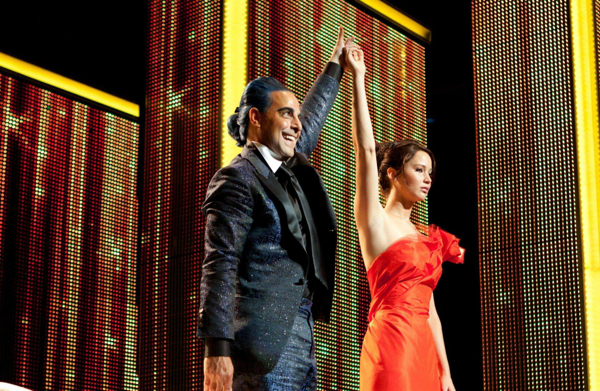Movie review by Greg Carlson
Suzanne Collins’ mighty young adult turned crossover publishing phenomenon “The Hunger Games” arrives in theatres as the franchise heir apparent to book series-to-screen juggernauts like “Harry Potter” and “Twilight.” With a ready-made fan base eager to see heroic Katniss Everdeen come alive in the person of Jennifer Lawrence, “The Hunger Games” will almost certainly make a very big star out of its talented lead. Lawrence’s Oscar-nominated work in “Winter’s Bone” runs in thematic parallel to the flinty “girl on fire,” a resourceful, intelligent, and welcome female leader in a world dominated by male action heroes.
Classifiably critic-proof, the release of “The Hunger Games” movie has already launched a library of interpretation, from critiques of clueless, racist Twitter users flabbergasted that certain characters (Rue in particular) are not played by white actors to iron-willed defenses of Koshun Takami’s “Battle Royale” as the unsung – and, until recently, largely unacknowledged – origin of Collins’ core story elements. Collins denied familiarity with “Battle Royale” in a detailed “New York Times” profile by Susan Dominus, shrewdly identifying the ancient Greek myth of Theseus and the Minotaur as her inspiration, but as Irene Peter quipped, “ignorance is no excuse, it’s the real thing.”
Certainly, dystopian fiction featuring life and death consequences did not originate with Takami’s novel, and “The Hunger Games” owes additional debts to Orwell’s “1984,” Jackson’s “The Lottery,” and Connell’s “The Most Dangerous Game,” to name just three items on a growing list of suggested influences. But whether one reads the novel as a protest of economic disparity between rich and poor, an expose of societal dependency on lowest-common-denominator reality television, an exploration of the horrors of war, or simply as an allegorical corollary to the real and imagined struggles of adolescence, “The Hunger Games” is elastic enough to withstand a variety of wide-ranging interpretations.
The production design, special effects, and costumes place “The Hunger Games” somewhere between “Twilight” and “Harry Potter” on the scale of visual value. The computer generated images of the galloping quadrupeds known as mutts outpace the werewolves of Forks, Washington, but the garish fright wigs and pancake makeup favored by the faux-aristocratic denizens of the imperial headquarters are deliberately redolent of foppish French Revolution-era aristocrats, and the enterprise often feels surprisingly cheap. With the ironic exception of the scenes in which Stanley Tucci’s Caesar Flickerman interviews the ill-fated tributes on television, many of the Capitol sets resemble something from made-for-TV movies.
Stylistically, “The Hunger Games” falters in its nausea-inducing handheld camerawork, a poor choice that offers no deep insight into the omnipresent media coverage demanded by the bloodthirsty Big Brothers of the Capitol – other than to serve as a weak reminder that nearly everything we see is presumably being captured for broadcast. Additionally, the demands of the film’s PG-13 rating drain the blood from Collins’ visceral descriptions of death in the arena. In place of the stark immediacy of the text, Ross dances around the horrors of children killing children, cutting away or staying in close to avoid showing any detail that might run afoul of the MPAA (the depiction of the tracker jacker attack is particularly flimsy and ineffective). One supposes there is some kind of insincerity suggested by the movie’s compromise position, but the broken state of the movie ratings system offers no alternative for a massive, mainstream release.
